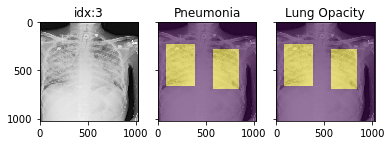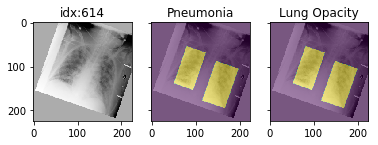🚨 Paper now online! https://arxiv.org/abs/2111.00595
🚨 Documentation now online! https://mlmed.org/torchxrayvision/
TorchXRayVision
| <img src="https://raw.githubusercontent.com/mlmed/torchxrayvision/master/docs/torchxrayvision-logo.png" width="300px"/> | (🎬 promo video) <br><img src="http://img.youtube.com/vi/Rl7xz0uULGQ/0.jpg" width="400px"/>) |
|---|
What is it?
A library for chest X-ray datasets and models. Including pre-trained models.
TorchXRayVision is an open source software library for working with chest X-ray datasets and deep learning models. It provides a common interface and common pre-processing chain for a wide set of publicly available chest X-ray datasets. In addition, a number of classification and representation learning models with different architectures, trained on different data combinations, are available through the library to serve as baselines or feature extractors.
- In the case of researchers addressing clinical questions it is a waste of time for them to train models from scratch. To address this, TorchXRayVision provides pre-trained models which are trained on large cohorts of data and enables 1) rapid analysis of large datasets 2) feature reuse for few-shot learning.
- In the case of researchers developing algorithms it is important to robustly evaluate models using multiple external datasets. Metadata associated with each dataset can vary greatly which makes it difficult to apply methods to multiple datasets. TorchXRayVision provides access to many datasets in a uniform way so that they can be swapped out with a single line of code. These datasets can also be merged and filtered to construct specific distributional shifts for studying generalization.
Twitter: @torchxrayvision
Getting started
$ pip install torchxrayvision
import torchxrayvision as xrv import skimage, torch, torchvision # Prepare the image: img = skimage.io.imread("16747_3_1.jpg") img = xrv.datasets.normalize(img, 255) # convert 8-bit image to [-1024, 1024] range img = img.mean(2)[None, ...] # Make single color channel transform = torchvision.transforms.Compose([xrv.datasets.XRayCenterCrop(),xrv.datasets.XRayResizer(224)]) img = transform(img) img = torch.from_numpy(img) # Load model and process image model = xrv.models.DenseNet(weights="densenet121-res224-all") outputs = model(img[None,...]) # or model.features(img[None,...]) # Print results dict(zip(model.pathologies,outputs[0].detach().numpy())) {'Atelectasis': 0.32797316, 'Consolidation': 0.42933336, 'Infiltration': 0.5316924, 'Pneumothorax': 0.28849724, 'Edema': 0.024142697, 'Emphysema': 0.5011832, 'Fibrosis': 0.51887786, 'Effusion': 0.27805611, 'Pneumonia': 0.18569896, 'Pleural_Thickening': 0.24489835, 'Cardiomegaly': 0.3645515, 'Nodule': 0.68982, 'Mass': 0.6392845, 'Hernia': 0.00993878, 'Lung Lesion': 0.011150705, 'Fracture': 0.51916164, 'Lung Opacity': 0.59073937, 'Enlarged Cardiomediastinum': 0.27218717}
A sample script to process images usings pretrained models is process_image.py
$ python3 process_image.py ../tests/00000001_000.png
{'preds': {'Atelectasis': 0.50500506,
'Cardiomegaly': 0.6600903,
'Consolidation': 0.30575264,
'Edema': 0.274184,
'Effusion': 0.4026162,
'Emphysema': 0.5036339,
'Enlarged Cardiomediastinum': 0.40989172,
'Fibrosis': 0.53293407,
'Fracture': 0.32376793,
'Hernia': 0.011924741,
'Infiltration': 0.5154413,
'Lung Lesion': 0.22231922,
'Lung Opacity': 0.2772148,
'Mass': 0.32237658,
'Nodule': 0.5091847,
'Pleural_Thickening': 0.5102617,
'Pneumonia': 0.30947986,
'Pneumothorax': 0.24847917}}
Models (demo notebook)
Specify weights for pretrained models (currently all DenseNet121)
Note: Each pretrained model has 18 outputs. The all model has every output trained. However, for the other weights some targets are not trained and will predict randomly becuase they do not exist in the training dataset. The only valid outputs are listed in the field {dataset}.pathologies on the dataset that corresponds to the weights.
## 224x224 models model = xrv.models.DenseNet(weights="densenet121-res224-all") model = xrv.models.DenseNet(weights="densenet121-res224-rsna") # RSNA Pneumonia Challenge model = xrv.models.DenseNet(weights="densenet121-res224-nih") # NIH chest X-ray8 model = xrv.models.DenseNet(weights="densenet121-res224-pc") # PadChest (University of Alicante) model = xrv.models.DenseNet(weights="densenet121-res224-chex") # CheXpert (Stanford) model = xrv.models.DenseNet(weights="densenet121-res224-mimic_nb") # MIMIC-CXR (MIT) model = xrv.models.DenseNet(weights="densenet121-res224-mimic_ch") # MIMIC-CXR (MIT) # 512x512 models model = xrv.models.ResNet(weights="resnet50-res512-all") # DenseNet121 from JF Healthcare for the CheXpert competition model = xrv.baseline_models.jfhealthcare.DenseNet() # Official Stanford CheXpert model model = xrv.baseline_models.chexpert.DenseNet(weights_zip="chexpert_weights.zip") # Emory HITI lab race prediction model model = xrv.baseline_models.emory_hiti.RaceModel() model.targets -> ["Asian", "Black", "White"] # Riken age prediction model model = xrv.baseline_models.riken.AgeModel()
Benchmarks of the modes are here: BENCHMARKS.md and the performance of some of the models can be seen in this paper arxiv.org/abs/2002.02497.
Autoencoders
You can also load a pre-trained autoencoder that is trained on the PadChest, NIH, CheXpert, and MIMIC datasets.
ae = xrv.autoencoders.ResNetAE(weights="101-elastic") z = ae.encode(image) image2 = ae.decode(z)
Segmentation
You can load pretrained anatomical segmentation models. Demo Notebook
seg_model = xrv.baseline_models.chestx_det.PSPNet() output = seg_model(image) output.shape # [1, 14, 512, 512] seg_model.targets # ['Left Clavicle', 'Right Clavicle', 'Left Scapula', 'Right Scapula', # 'Left Lung', 'Right Lung', 'Left Hilus Pulmonis', 'Right Hilus Pulmonis', # 'Heart', 'Aorta', 'Facies Diaphragmatica', 'Mediastinum', 'Weasand', 'Spine']

Datasets
View docstrings for more detail on each dataset and Demo notebook and Example loading script
transform = torchvision.transforms.Compose([xrv.datasets.XRayCenterCrop(), xrv.datasets.XRayResizer(224)]) # RSNA Pneumonia Detection Challenge. https://pubs.rsna.org/doi/full/10.1148/ryai.2019180041 d_kaggle = xrv.datasets.RSNA_Pneumonia_Dataset(imgpath="path to stage_2_train_images_jpg", transform=transform) # CheXpert: A Large Chest Radiograph Dataset with Uncertainty Labels and Expert Comparison. https://arxiv.org/abs/1901.07031 d_chex = xrv.datasets.CheX_Dataset(imgpath="path to CheXpert-v1.0-small", csvpath="path to CheXpert-v1.0-small/train.csv", transform=transform) # National Institutes of Health ChestX-ray8 dataset. https://arxiv.org/abs/1705.02315 d_nih = xrv.datasets.NIH_Dataset(imgpath="path to NIH images") # A relabelling of a subset of NIH images from: https://pubs.rsna.org/doi/10.1148/radiol.2019191293 d_nih2 = xrv.datasets.NIH_Google_Dataset(imgpath="path to NIH images") # PadChest: A large chest x-ray image dataset with multi-label annotated reports. https://arxiv.org/abs/1901.07441 d_pc = xrv.datasets.PC_Dataset(imgpath="path to image folder") # COVID-19 Image Data Collection. https://arxiv.org/abs/2006.11988 d_covid19 = xrv.datasets.COVID19_Dataset() # specify imgpath and csvpath for the dataset # SIIM Pneumothorax Dataset. https://www.kaggle.com/c/siim-acr-pneumothorax-segmentation d_siim = xrv.datasets.SIIM_Pneumothorax_Dataset(imgpath="dicom-images-train/", csvpath="train-rle.csv") # VinDr-CXR: An open dataset of chest X-rays with radiologist's annotations. https://arxiv.org/abs/2012.15029 d_vin = xrv.datasets.VinBrain_Dataset(imgpath=".../train", csvpath=".../train.csv") # National Library of Medicine Tuberculosis Datasets. https://www.ncbi.nlm.nih.gov/pmc/articles/PMC4256233/ d_nlmtb = xrv.datasets.NLMTB_Dataset(imgpath="path to MontgomerySet or ChinaSet_AllFiles")
Dataset fields
Each dataset contains a number of fields. These fields are maintained when xrv.datasets.Subset_Dataset and xrv.datasets.Merge_Dataset are used.
-
.pathologiesThis field is a list of the pathologies contained in this dataset that will be contained in the.labelsfield ]. -
.labelsThis field contains a 1,0, or NaN for each label defined in.pathologies. -
.csvThis field is a pandas DataFrame of the metadata csv file that comes with the data. Each row aligns with the elements of the dataset so indexing using.ilocwill work.
If possible, each dataset's .csv will have some common fields of the csv. These will be aligned when The list is as follows:
-
csv.patientidA unique id that will uniqely identify samples in this dataset -
csv.offset_day_intAn integer time offset for the image in the unit of days. This is expected to be for relative times and has no absolute meaning although for some datasets it is the epoch time. -
csv.age_yearsThe age of the patient in years. -
csv.sex_maleIf the patient is male -
csv.sex_femaleIf the patient is female
Dataset tools
relabel_dataset will align labels to have the same order as the pathologies argument.
xrv.datasets.relabel_dataset(xrv.datasets.default_pathologies , d_nih) # has side effects
specify a subset of views (demo notebook)
d_kaggle = xrv.datasets.RSNA_Pneumonia_Dataset(imgpath="...", views=["PA","AP","AP Supine"])
specify only 1 image per patient
d_kaggle = xrv.datasets.RSNA_Pneumonia_Dataset(imgpath="...", unique_patients=True)
obtain summary statistics per dataset
d_chex = xrv.datasets.CheX_Dataset(imgpath="CheXpert-v1.0-small", csvpath="CheXpert-v1.0-small/train.csv", views=["PA","AP"], unique_patients=False) CheX_Dataset num_samples=191010 views=['PA', 'AP'] {'Atelectasis': {0.0: 17621, 1.0: 29718}, 'Cardiomegaly': {0.0: 22645, 1.0: 23384}, 'Consolidation': {0.0: 30463, 1.0: 12982}, 'Edema': {0.0: 29449, 1.0: 49674}, 'Effusion': {0.0: 34376, 1.0: 76894}, 'Enlarged Cardiomediastinum': {0.0: 26527, 1.0: 9186}, 'Fracture': {0.0: 18111, 1.0: 7434}, 'Lung Lesion': {0.0: 17523, 1.0: 7040}, 'Lung Opacity': {0.0: 20165, 1.0: 94207}, 'Pleural Other': {0.0: 17166, 1.0: 2503}, 'Pneumonia': {0.0: 18105, 1.0: 4674}, 'Pneumothorax': {0.0: 54165, 1.0: 17693}, 'Support Devices': {0.0: 21757, 1.0: 99747}}
Pathology masks (demo notebook)
Masks are available in the following datasets:
xrv.datasets.RSNA_Pneumonia_Dataset() # for Lung Opacity xrv.datasets.SIIM_Pneumothorax_Dataset() # for Pneumothorax xrv.datasets.NIH_Dataset() # for Cardiomegaly, Mass, Effusion, ...
Example usage:
d_rsna = xrv.datasets.RSNA_Pneumonia_Dataset(imgpath="stage_2_train_images_jpg", views=["PA","AP"], pathology_masks=True) # The has_masks column will let you know if any masks exist for that sample d_rsna.csv.has_masks.value_counts() False 20672 True 6012 # Each sample will have a pathology_masks dictionary where the index # of each pathology will correspond to a mask of that pathology (if it exists). # There may be more than one mask per sample. But only one per pathology. sample["pathology_masks"][d_rsna.pathologies.index("Lung Opacity")]


it also works with data_augmentation if you pass in data_aug=data_transforms to the dataloader. The random seed is matched to align calls for the image and the mask.

Distribution shift tools (demo notebook)
The class xrv.datasets.CovariateDataset takes two datasets and two
arrays representing the labels. The samples will be returned with the
desired ratio of images from each site. The goal here is to simulate
a covariate shift to make a model focus on an incorrect feature. Then
the shift can be reversed in the validation data causing a catastrophic
failure in generalization performance.
ratio=0.0 means images from d1 will have a positive label ratio=0.5 means images from d1 will have half of the positive labels ratio=1.0 means images from d1 will have no positive label
With any ratio the number of samples returned will be the same.
d = xrv.datasets.CovariateDataset(d1 = # dataset1 with a specific condition d1_target = #target label to predict, d2 = # dataset2 with
编辑推荐精选


TRAE编程
AI辅助��编程,代码自动修复
Trae是一种自适应的集成开发环境(IDE),通过自动化和多元协作改变开发流程。利用Trae,团队能够更快速、精确地编写和部署代码,从而提高编程效率和项目交付速度。Trae具备上下文感知和代码自动完成功能,是提升开发效率的理想工具。


博思AIPPT
AI一键生成PPT,就用博思AIPPT!
博思AIPPT,新一代的AI生成PPT平台,支持智能生成PPT、AI美化PPT、文本&链接生成PPT、导入Word/PDF/Markdown文档生成PPT等,内置海量精美PPT模板,涵盖商务、教育、科技等不同风格,同时针对每个页面提供多种版式,一键自适应切换,完美适配各种办公场景。


潮际好麦
AI赋能电商视觉革命,一站式智能商拍平台
潮际好麦深耕服装行业,是国内AI试衣效果最好的软件。使用先进AIGC能力为电商卖家批量提供优质的、低成本的商拍图。合作品牌有Shein、Lazada、安踏、百丽等65个国内外头部品牌,以及国内10万+淘宝、天猫、京东等主流平台的品牌商家,为卖家节省将近85%的出图成本,提升约3倍出图效率,让品牌能够快速上架。


iTerms
企业专属的AI法律顾问
iTerms是法大大集团旗下法律子品牌,基于最先进的大语言模型(LLM)、专业的法律知识库和强大的智能体架构,帮助企业扫清合规障碍,筑牢风控防线,成为您企业专属的AI法律顾问。


SimilarWeb流量提升
稳定高效的流量提升解决方案,助力品牌曝光
稳定高效的流量提升解决方案,助力品牌曝光


Sora2视频免费生成
最新版Sora2模型免费使用,一键生成无水印视频
最新版Sora2模型免费使用,一键生成无水印视频


Transly
实时语音翻译/同声传译工具
Transly是一个多场景的AI大语言模型驱动的同声传译、专业翻译助手,它拥有超精准的音频识别翻译能力,几乎零延迟的使用体验和支持多国语言可以让你带它走遍全球,无论你是留学生、商务人士、韩剧美剧爱好者,还是出国游玩、多国会议、跨国追星等等,都可以满足你所有需要同传的场景需求,线上线下通用,扫除语言障碍,让全世界的语言交流不再有国界。


讯飞绘文
选题、配图、成文,一站式创作,让内容运营更高效
讯飞绘文,一个AI集成平台,支持写作、选题、配图、排版和发布。高效生成适用于各类媒体的定制内容,加速品牌传播,提升内容营销效果。


商汤小浣熊
最强AI数据分析助手
小浣熊家族Raccoon,您的AI智能助手,致力于通过先进的人工智能技术,为用户提供高效、便捷的智能服务。无论是日常咨询还是专业问题解答,小浣熊都能以快速、准确的响应满足您的需求,让您的生活更加智能便捷。


imini AI
像人一样思考的AI智能体
imini 是一款超级AI智能体,能根据人类指令,自主思考、自主完成、并且交付结果的AI智能体。
推荐工具精选
AI云服务特惠
懂AI专属折扣关注微信公众号
最新AI工具、AI资讯
独家AI资源、AI项目落地

微信扫一扫关注公众号




